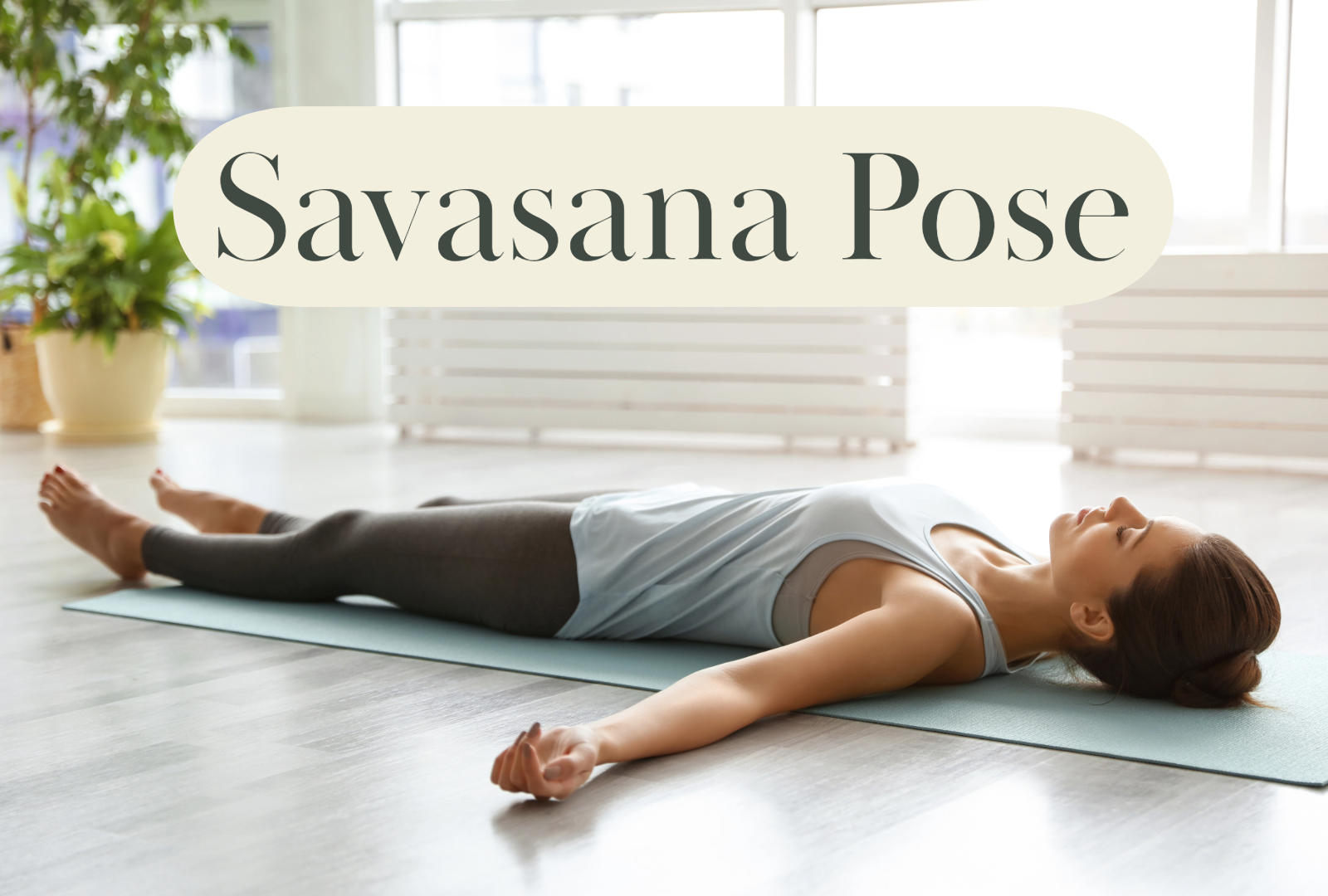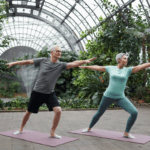Coming Soon: E-book about Kundalini Yoga - Sign up here to be among the first to get it!
Sanskrit: Corpse Pose
Type: Supine Pose
Chakra Involved: Crown Chakra (Sahasrara Chakra), Heart Chakra (Anahata Chakra)

Savasana (Corpse Pose)
Savasana, also known as Corpse Pose, marks the conclusion of a yoga practice, serving as a moment for deep relaxation and integration. This pose allows the body to absorb the benefits of the practice, promoting rest and rejuvenation. Despite its simplicity, Savasana is often considered one of the most challenging poses, as it requires complete surrender and the stilling of the mind.
Starting Position
Begin by lying flat on your back on a yoga mat or comfortable surface. Ensure you have a quiet, distraction-free environment. Keep any props you may need, such as blankets or a bolster, close by.
Step-by-step Instruction
- Lie Down: Gently lower yourself to the floor, lying on your back. Let your legs extend straight out, slightly apart, allowing your feet to fall open naturally.
- Position Your Arms: Place your arms alongside your body, palms facing upward, a few inches away from your torso. This position encourages your shoulders to relax and open.
- Relax Your Body: Close your eyes and take a deep breath in. As you exhale, consciously relax each part of your body, starting from your toes and moving up to the crown of your head.
- Let Go: Allow your body to feel heavy on the ground. Release any tension in your jaw, soften your gaze behind your closed eyelids, and let your tongue rest gently in your mouth.
- Breathe Naturally: Let your breath flow freely and naturally, without trying to control or shape it. Focus on the rise and fall of your belly with each breath.
- Stay in the Pose: Remain in Savasana for 5-10 minutes, or longer if you have the time. Use this opportunity to let go of any thoughts, plans, or judgments. Simply be present in the moment.
To Release the Pose
- Gently Awaken: Start to deepen your breath, bringing gentle movement back to your fingers and toes. Wiggle your fingers, toes, ankles, and wrists.
- Stretch: Stretch your arms overhead, lengthening your body with a deep inhale.
- Roll to One Side: Bend your knees and roll onto your right side, resting in a fetal position for a few moments.
- Come Up to Seated: Using your hands for support, gently push yourself up to a comfortable seated position. Open your eyes when you feel ready.
Teacher’s Tip
- Create a Comfortable Environment: Encourage students to use props such as blankets, bolsters under the knees, or a pillow under the head for added comfort. The more physically comfortable they are, the easier it will be to relax deeply.
- Guide Relaxation: Use a soft voice to guide a body scan, starting from the toes and moving upwards, inviting each part of the body to relax and let go.
- Encourage Mental Release: Remind students that it’s natural for the mind to wander. Encourage them to acknowledge their thoughts without attachment and gently guide their attention back to their breath or the sensation of relaxation.
- Integration: Emphasize the importance of Savasana in integrating the benefits of the yoga practice. It’s a crucial time for the body to assimilate the work done during the session and to restore balance.
Savasana is a powerful tool for stress relief and relaxation, offering profound benefits for the mind, body, and spirit. It’s an essential part of yoga practice, symbolizing the release of effort and the embrace of peace and stillness.
Variations of Savasana (Corpse Pose)
While Savasana is fundamentally a simple pose, its variations can accommodate different needs, enhance comfort, and address specific areas for relaxation or support. Here are some common variations along with instructions for each:
1. Savasana with Bolster under Knees
- Instructions: Place a bolster or rolled blanket under your knees to alleviate any lower back tension. This adjustment allows the lower back to rest more comfortably on the ground, facilitating deeper relaxation.
2. Savasana with a Blanket
- Instructions: Lay a blanket over your body to provide warmth and a sense of security. The slight weight of the blanket can also offer a grounding effect, helping to calm the nervous system.
3. Savasana with Eye Pillow
- Instructions: Place a lightly weighted eye pillow over your eyes. The gentle pressure helps to soothe the eyes and forehead, encouraging deeper relaxation and blocking out any distracting light.
4. Supported Savasana
- Instructions: Use various props for added comfort and support. Place a bolster under your knees, a folded blanket under your head, and perhaps a rolled blanket or bolster under your ankles. Adjust the props to your body’s needs to achieve the most comfortable position possible.
5. Savasana with Hands on Body
- Instructions: Place one hand on your heart and the other on your abdomen. This variation can create a more introspective experience, helping to center your awareness on your breath and heartbeat, fostering a sense of calm and connection.
6. Side-Lying Savasana
- Instructions: Lie on your side, with a bolster or pillow between your knees and a pillow under your head. This variation is particularly beneficial for those who find lying on their back uncomfortable, including pregnant women.
7. Chair Savasana
- Instructions: Sit comfortably in a chair with your back supported, feet flat on the floor, and hands resting on your thighs or in your lap. Close your eyes and focus on deep, rhythmic breathing. This seated version is ideal for those who cannot lie down comfortably or have limited mobility.
Implementation Tips
- Personal Comfort: Encourage students to adjust their position and use props as needed to find the most comfortable and supportive arrangement for their body.
- Quiet Environment: Ensure the environment is conducive to relaxation, possibly dimming lights or playing soft, ambient music to help students relax more deeply.
- Guided Relaxation: Consider guiding students through a body scan or gentle breathing exercise to help them settle into the pose and release tension.
- Time Allowance: Allow ample time for Savasana, giving students enough space to fully embrace the benefits of relaxation and integration after their practice.
These variations of Savasana can help make this essential pose accessible and comfortable for everyone, regardless of their physical condition or personal preferences, ensuring that all practitioners can conclude their yoga session with a moment of deep rest and rejuvenation.
FAQs About Savasana (Corpse Pose)
Savasana, or Corpse Pose, offers profound benefits for both the mind and body, making it an essential component of yoga practice:
- Promotes Deep Relaxation: Helps the body enter a state of deep relaxation, reducing stress and anxiety.
- Improves Concentration: By calming the mind, Savasana can improve focus and concentration.
- Enhances Body Awareness: Encourages mindfulness and a deeper connection with one’s body.
- Relieves Fatigue: Helps alleviate physical and mental fatigue, rejuvenating the body.
- Lowers Blood Pressure: Can aid in lowering blood pressure and calming the nervous system.
- Aids Digestion: The relaxation effect can also positively affect the digestive system.
- Facilitates Healing: By reducing stress, Savasana supports the body’s natural healing processes.
The recommended duration for Savasana is typically 5 to 10 minutes, but even a few minutes can be beneficial if time is limited. For deeper relaxation or in a more restorative yoga practice, staying in Savasana for 15 minutes or longer can be particularly nourishing.
While the goal of Savasana is conscious relaxation rather than sleep, falling asleep can happen, especially if one is very tired or new to the practice. If it occurs, it indicates a need for rest. Over time, as one becomes more accustomed to the practice, staying awake and aware during Savasana while still deeply relaxing becomes easier.
The purpose of Savasana is to integrate and assimilate the benefits of the yoga practice on a deep level. It allows the body and mind to absorb and process the effects of the poses and movements that preceded it. Savasana is a moment of stillness and conscious relaxation, which contrasts with the activity of the rest of the practice, offering balance. It teaches the art of letting go and surrendering both physically and mentally, which can have profound effects on one’s ability to manage stress and approach life with a more calm and balanced perspective.




